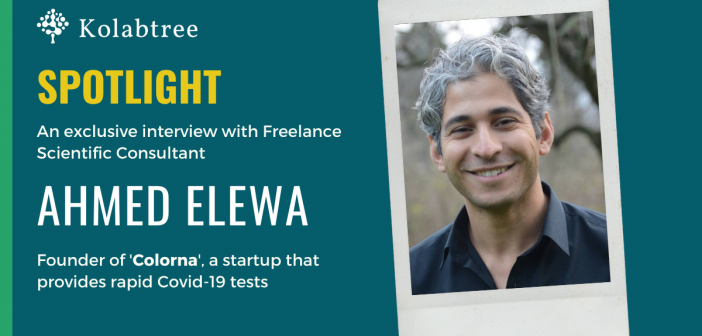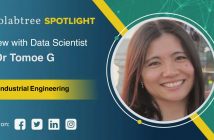Kolabtree’s scientific freelancer Dr. Ahmed Elewa on securing funding for his startup Colorna that provides a rapid OTC test for COVID-19, and his intriguing past research that includes studying how salamanders grow their arms back.
A biologist and bioinformatician, Dr. Ahmed Elewa did his doctoral research with a Nobel laureate. As a postdoc, he also led a project that sequenced one of the largest genomes to date. He has several publications across diverse fields such as religion, philosophy and law to his name.
As the Co-Founder and Chief Scientific Officer at Colorna, he was responsible for the development of rapid over-the-counter testing for SARS-CoV-2. He also takes up a diverse range of projects as a freelance scientist on Kolabtree, executing scientific analyses, writing and editing.
As part of the spotlight series, I had a chance to sit down with Dr. Elewa to discuss how he designed R&D and secured funding for his startup. We also talk through his experience of being a scientific freelancer on Kolabtree and his previous research work, which includes intriguing discoveries such as how embryos make their gut and how salamanders grow their arms back.
NM: Congratulations on securing funding for your startup! Your company Colorna provides a rapid OTC test for COVID-19. Can you tell us more about this please?
AE: Thank you! When COVID-19 became a full-blown pandemic, it was clear that virus tests were going to be a global necessity. The golden standard that uses PCR is pretty outdated compared to new diagnostic methods that have been developed over the past decade. PCR tests are also centralized, so you have to worry about the logistics of sample transport to a lab and then reporting the results back to each person.
Our vision was to take the best new techniques developed over the past decade and turn them into a home test so that virus testing can be more distributed. Initially we worked on a split-peroxidase biosensor method and then switched to LAMP detection in collaboration with the Pelechano Lab at Karolinska Institute.
We prototyped a personal device and developed ways to detect viruses from crude saliva. The last part, detecting virus from saliva without RNA extraction is the main technical hurdle facing OTC virus tests that detect RNA.
NM: You’ve had years of intensive research experience. What was it like to work on the industry side of things, and lead R&D for the startup?
AE: I found leading R&D for a startup absolutely exhilarating! There’s a thrill every single day and compared to my experience in academia, I was 10 times more efficient. Right before the startup, I was on the academic job market. After a few interviews for assistant professor positions, I didn’t get any job offers. But ever since I was an undergraduate, I always wanted to run my own lab, so leading R&D for Colorna gave me that experience after all.
NM: Did you need the support of experts to get your startup up and running? It must not have been easy given the restrictions imposed by COVID-19.
AE: The initial vision behind Colorna (OTC home test) was a proposal I made to an academic lab at Stockholm University and SciLifeLabs. The professor was excited about the project and agreed to have me join his lab to execute. However, the hiring process was going to take a couple of months and I felt an urgency to get started right away. I told a friend of mine about the situation and he introduced me to angel investors at WeFightCovid.org.
When I shared the story with them, they agreed to fund a startup to get the project started. So, in terms of expert support, I went back to the professor and he agreed to be a Scientific Advisor and also allowed Colorna to rent a bench in his lab. Also, all of this was going on in Sweden, which never had any serious lockdowns. We were able to meet, discuss and execute while practicing social distancing and common sense.
NM: Can you talk us through obtaining funding from WeFightCovid.org and the Norrsken foundation? What were the highlights of the negotiation process?
AE: Sure. WeFightCovid.org was founded by a group of tech entrepreneurs that predicted the consequences of the pandemic and shorted a bunch of stocks betting that their prices would drop (for example airline companies). They ended up with 5 million euros as a result of their bets and wanted to use that money to help mitigate the effects of COVID-19.
So, they started several initiatives to aid health workers and sectors of society that would be hit the most by the pandemic. They also wanted to fund research. When I met with them, their main requirements were a clear budget and a plan that would yield results in a month or two. I created a budget and research plan for intensive R&D that would conclude in a month whether or not the proposed method for virus detection would work. The budget was designed to minimize wasted time and money and to properly compensate anyone who would work with us, given the urgency.
Then, there were a few meetings to get to know each other more and after the third meeting I got a commitment, with the condition that they assign the CEO. We then pitched to Norrsken the day after and when they saw that Colorna already had the support of WeFightCovid.org and heard our vision and saw our team they matched the seed fund. The only condition both foundations had was that if we were to move on to another round of funding, they would get priority and privileged options.
NM: We’d love to learn more about your research that resulted in 8 publications. First off, why salamanders?! Tell us more about the whole salamander genome paper.
AE: (Smiles) I think they’re a bit more than eight. I generally have a broad set of interests. In fact one of my most cited publications is a paper on Feminism and Islamic Law. By the end of my Ph.D. I was exhausted and didn’t know if I wanted to keep on doing research. At the same time, I never imagined myself doing something else. So, I thought hard about the biggest questions in biology and chose three topics that really excited me.
I ended up moving to Sweden to learn how to study salamander regeneration. It is absolutely marvellous to see an animal regrow an entire arm in just a couple months! They can also repair their hearts, brains and pretty much, if an injury doesn’t kill them, they can repair themselves. You’d imagine that such super animals would dominate the world, but no. Salamanders are in fact meek and humble. There’s a lot to learn from them in terms of resilience and reserve.
NM: You’ve studied how worm embryos make their gut, salamanders grow back their arms back and how genes behave. Tell us one completely bizarre, weird and wonderful thing that you’ve seen in your years of research.
AE: Yes! During my doctoral studies… in fact during my first meeting with my future advisor, this was like fifteen years ago. We were in his office discussing how worms make small RNAs and pass them down to their children to control gene activity. We were riffing off of each other’s ideas, thinking out loud when I said, well imagine if a worm learns something and the small RNAs in its brain control genes to make that memory stable. Then imagine if those small RNAs are passed down to the children and control genes in their brains so that they are born already knowing what the parents had learned! I tried testing this and failed a lot.
Then one morning I saw a paper that just came out of Cori Bargmann’s lab on how worms learn to avoid eating bacteria that smell nice but make them sick. So, I put worms with the attractive bacteria and watched them eat and then learn to avoid that food. Then I asked if their children would hatch with a normal attraction to the bacteria, or if they would have acquired some knowledge to avoid that nice smell. And indeed! Children of worms that learned the lesson tended to avoid the bacteria more than children of worms that didn’t encounter the bacteria before. Even more, this “inherited wisdom”, as we lightly called it in the lab, was lost in worms that couldn’t make small RNAs.
This was all really awesome but also just preliminary results. It was really cool to imagine that generations can pass down circumstantial experiences like this. Nowadays, we know a lot about this phenomenon from excellent work by a few labs around the world, especially the Rechavi and Murphy labs. But back then it was just really heretical and cool!
NM: What prompted you to explore working as a scientific freelancer? What kind of projects interest you?
AE: Well, the whole reason I started Colorna was to actually have a source of income again. In 2018 I moved back to the US to do a short postdoc while I applied for faculty positions. However, in late 2019 I decided to leave that lab because it was just an awful work environment, but it was hard to convince any other lab to hire me for just a few months while I interviewed for faculty positions. So, I hedged my bets on getting a faculty position and lived off my savings and borrowed money from my brother. So, when I didn’t get any offers, I needed a job ASAP, especially as the pandemic began. I thought starting my own company would offer some level of income security.
Little did I know that a pervasive culture in the startup world is not compensating workers during the first phase, as a demonstration of commitment to the company’s vision. I fought tooth and nail so the CEO would sign off on my salary that was in the original budget. Eventually, I realized that I couldn’t afford the luxury of working on a startup without any savings and without getting a salary. At the same time, applying for new jobs on LinkedIn was going nowhere or I was deemed overqualified when I did get an interview.
There was only one promising prospect but it was going to take three months before the first paycheck. When I asked a friend to lend me $500 for my son’s school tuition, he apologized saying that he’s strapped for cash as well but encouraged me to freelance. I was like, damn he’s right, my son freelances on Fiverr and actually makes a buck. So, I went on 10 different platforms that night and really found myself on Kolabtree.
I mainly do projects that involve bioinformatic analysis. However, the projects that interest me most are the ones that are a little bit outside my comfort zone and require that I learn something new in a short amount of time. I also have a soft spot for science fair projects and love to see how smart and creative students can be. So I’m happy discussing those projects and helping out with statistics or plots and figures for free.
NM: What can platforms like Kolabtree do better to make the best experts in science like you more accessible to businesses?
AE: I didn’t hear about Kolabtree until after researching scientific freelancers. I think most scientists in academia don’t know that such a platform exists. Here’s the thing, it’s difficult for most faculty to find qualified postdocs and when they do, they’re damn expensive. As a new assistant professor, you’ll pay at least $100,000 a year to hire a postdoc and cover their salary and benefits.
I think platforms like Kolabtree should start promoting the idea of outsourcing work so that new and small labs can get their projects moving without having to commit to hiring a full-time postdoc right away. Most grants would allow a Principal Investigator to hire a scientific freelancer, either through petty cash or by signing a contract with them as a ‘contractor’, depending on the scale of the project. Look, this is a very new space in general and there’s a lot that could be done to improve the service that scientific freelancers provide and to connect them with academia. There’s no reason why an intelligent person with a Ph.D. should be unemployed or have to stay in a toxic lab just to make ends meet.
There’s a lot of intellectual capital that Kolabtree and others can tap into. Imagine if you can hire a scientific freelancer to do something with the same ease that you can order test tubes! In the Data Analysis world, agencies will train you to become a data analyst and then make sure you get your first job. There should be similar training for Self Employed scientists and researchers. Except that the agency that trains you adds you to their freelancing network. In that case, maybe the agency would take a fixed subscription from the freelancer instead of a percentage of their revenue.
Also, Kolabtree should encourage freelance scientific experts working with each other and collaborate to execute large projects. Right now, the platform doesn’t allow two independent freelancers to submit a proposal together and share the money however they decide. As I get more used to this new space, I see different areas that could be improved, but it’s still new to me and I need more time.
This piece is part of Kolabtree’s Spotlight feature, where we showcase the lesser-known aspects of our extensive network of scientific freelance writers, regulatory specialists and other PHD-qualified experts who are available for on-demand hire
Looking for expert help? Post a project for free on Kolabtree or scout from our wide network of freelance scientific experts.







